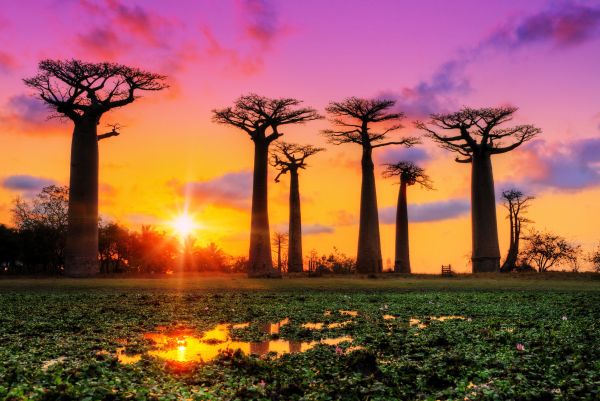The Avenue of the Baobabs, the most photographed place in western Madagascar.

About 130 million years ago, the current island of Madagascar separated from the African continent to settle in the Indian Ocean and lay off its other half, India.

Due to this division, the African island has one of the most curious and richest natural ecosystems in the world, and one of the best places to appreciate the particularity of the Malagasy environment is none other than the Avenue of the Baobabs.
What is a baobab?
First of all, let’s get to know a little about these trees. They are of the genus Adansonia and known as baobab, but also called bottle tree because of its shape or primate bread.

In the world there are about eight species of baobabs, of which six are found in Madagascar; they can reach a height of up to 30 meters and can live between 800 and 1000 years, which makes baobabs unique trees.
These bottle-bodied trees, according to a legend, were so, so conceited that a god turned them over, leaving the branches buried and the roots growing upwards. In fact, looking at some from afar, it gives the impression that the crown is roots.
When the roots point to the sky

To the northwest of the island of Madagascar, between the towns of Morondava and Belon’i, 25 baobab trees guard a dusty road as the only survivors of a tropical forest replaced by locals to promote agriculture, hence in Malagasy the baobab is known as renala or «Mother of the Forest», in honor of the largest and most impressive trees not only of the ancient forests of Madagascar, but of the entire world.
In 2007, the Ministry of Environment, Water and Forests named this Avenue of the Baobabs as the first protected monument on the island, a factor that has allowed these peculiar inhabitants of the Malagasy lands to be kept, whose symbolism for the locals encompasses endless of legends of unknown origin.
The envy of the gods
One of the legends tells that the gods were so jealous of the beauty of the baobab that they decided to punish them by turning their position and leaving the roots that any tourist can glimpse when passing through the island.

Other sources assure that the baobab’s envy towards other trees that did have fruits such as the palm or the fig tree was so great that the gods punished him in the same way.
Various tribes of Madagascar take the baobab as a living being that harbors good and bad spirits. During certain times, the natives deposit food and drink at the foot of the tree in order to satisfy those demons that many fear.

As many will know, the baobab is a recurring element in the famous book The Little Prince by Antoine de Saint-Exupéry, being the tree whose shoots grow on the planet of the protagonist child which it threatens to destroy.
How to get to Avenida de los Baobabs?
Since Madagascar is such a large island and it has roads in very poor condition, the distances to be traveled to see its natural beauty are immense. To get to Avenida de los Baobabs you have to go to the west of the island.
Where is the Avenida de los Baobabs located?
This famous avenue is located in the province of Menabe and is a dirt track, the RN8, that connects the towns of Morondava and Belo Sur Tsiribihina. On rainy days this road becomes muddy and can only be reached by 4 × 4 car.
Sunset on the Avenue of the Baobabs
After spending most of the day on the road, we arrived at the Avenida de los Baobabs, where we were impressed with the size of these unique trees.
Upon arrival, the sun was still a bit high, so, while we waited, we were able to take a walk among these giants watching the local people who go about their day walking along this track.
The Avenue of the Baobabs, in Madagascar, is the best showcase to contemplate a tree that, although it grows in other African countries such as Botswana or South Africa, acquires its greatest beauty and importance on the Malagasy island, since in addition to surviving an activity of the man who has allowed its durability over time.
The importance of the baobab in local folklore is such that even we ourselves would bow our heads after witnessing its powerful presence.